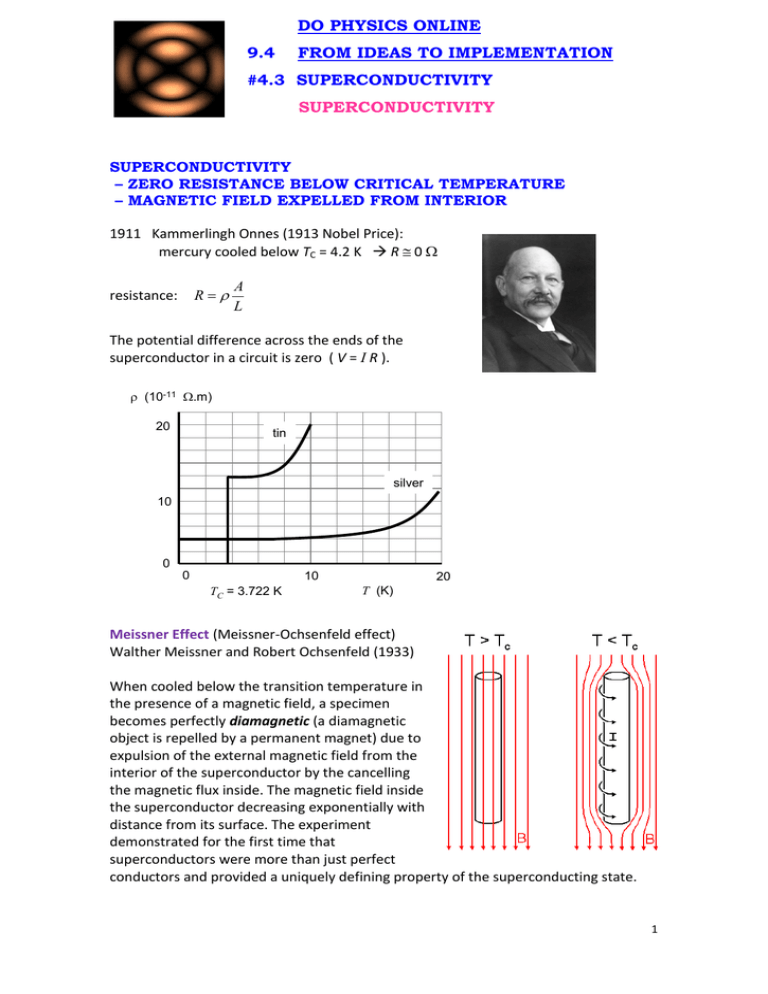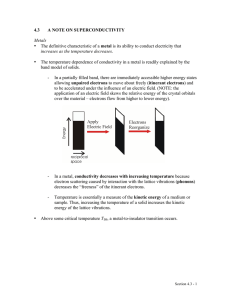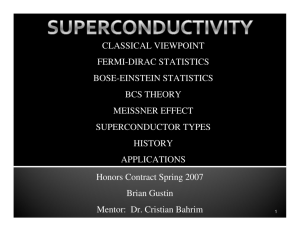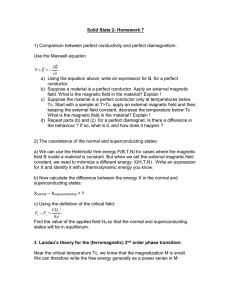Superconductivity
advertisement

DO PHYSICS ONLINE 9.4 FROM IDEAS TO IMPLEMENTATION #4.3 SUPERCONDUCTIVITY SUPERCONDUCTIVITY SUPERCONDUCTIVITY – ZERO RESISTANCE BELOW CRITICAL TEMPERATURE – MAGNETIC FIELD EXPELLED FROM INTERIOR 1911 Kammerlingh Onnes (1913 Nobel Price): mercury cooled below TC = 4.2 K R 0 R resistance: A L The potential difference across the ends of the superconductor in a circuit is zero ( V = I R ). (10-11 .m) 20 tin silver 10 0 0 10 TC = 3.722 K 20 T (K) Meissner Effect (Meissner-Ochsenfeld effect) Walther Meissner and Robert Ochsenfeld (1933) When cooled below the transition temperature in the presence of a magnetic field, a specimen becomes perfectly diamagnetic (a diamagnetic object is repelled by a permanent magnet) due to expulsion of the external magnetic field from the interior of the superconductor by the cancelling the magnetic flux inside. The magnetic field inside the superconductor decreasing exponentially with distance from its surface. The experiment demonstrated for the first time that superconductors were more than just perfect conductors and provided a uniquely defining property of the superconducting state. 1 If a small magnet is brought near a superconductor, it will be repelled because induced super-currents around the surface will produce mirror images of each pole, that is, it can be levitated by this repulsive force. When the sample is warm and the electrons are not "paired up", it is easy to place the magnet on the surface. Doing so causes the magnetic field from the magnet to penetrate into the sample. Then the sample is cooled and the electrons undergo the phase change. If the sample was a perfect conductor, nothing at all should happen. This is due to the fact that conductors do not like any form of change in magnetic fields. So where the magnet sits it should sit forever. But the superconductor will actually manage to remove the now present magnetic field from its interior. It accomplishes this by spontaneously running electric currents on the surface where no currents existed a moment before. The direction of the currents will be such as to create an opposing magnetic field to cancel the one present (use right hand grip rule). As a result, the magnetic field coming from the sample will interact with that of the permanent magnet creating enough repulsion force to levitate the magnet again. However, if the external magnetic field increased beyond a certain value called critical value, BC, the material ceases to be superconducting and becomes normal. At high magnetic field strengths there is not enough energy to set up surface currents to cancel the magnetic field inside the semiconductor. Also, if the current within the superconductor is too large, then the material returns to its normal non-superconducting state. The critical value of the current is IC. IC BC normal superconducting normal superconducting TC TC 2 Consider a loop of superconductor placed into a magnetic field, with the loop perpendicular to the field. The superconducting loop is cooled below its critical temperature, currents are established (as shown) on the inner and outer surfaces of the ring, cancelling the external field in the interior of the superconducting. When the external magnetic field is switched off, the outside surface current disappears and the inside current persists. The result is a non-attenuating electric current induced in the loop which can circulate for an unlimited time with a magnetic flux trapped in the hole enclosed by the ring. 3 BSC THEORY OF SUPERCONDUCTIVITY In 1957, John Bardeen. Leon Cooper, Robert Schrieffer (1972 Nobel Prize) proposed a quantum mechanical theory (electrons described by wave functions) known as BCS theory to explain superconductivity in Type 1 superconductors. The predictions of this theory are in excellent agreement with experimental results. John Bardeen Leon Cooper Robert Schrieffer Evidence for lattice – electron interaction came from experiments in 1950 (isotope effect) which showed that the critical temperature was dependent on the mass of different isotopes of the same element, the greater the mass, the smaller the critical temperature. It is not possible to give a clearly explanation of superconductivity without the full complex mathematical treatment in which the wave-like properties of an electron are used. “Hand Waving Arguments” BSC Theory for Type 1 Superconductors 1. An electron has a Coulomb attraction to the lattice ions giving extra momentum to the electron and lattice as they are slightly pulled together. 2. Increased positive charge density of lattice due to the deformation of the ion lattice. Can think of it like the electron emitting a virtual phonon (a phonon is a quantum mechanical description of an elementary vibrational motion in which a lattice of atoms or molecules uniformly oscillates at a single frequency) which is absorbed by the lattice. 3. Another electron passing near the region of increased positive charged density will absorb all the momentum from the lattice due to the Coulomb interaction resulting in the second electron absorbing a phonon thereby absorbing the momentum supplied by the first electron. 4. The net effect is that the two electrons have exchanged some momentum with each other. The attractive interaction between the two electrons was a twostep process involving the phonon as an intermediary. The attraction between the two electrons due to successive phonon exchanges can exceed slightly the repulsive force which they exert directly on each other because of the shielded Coulomb interaction of their like charges. The ionic lattice plays the role of an intermediate medium whose presence results in attraction between electrons. 5. The pair of electrons are weakly bound together forming a Cooper pair. It is the Cooper pairs that are responsible for superconductivity. 4 Cooper pairs Need large numbers of Cooper pairs for superconductivity 1. Low temperatures so that thermal lattice vibrations don’t inhibit the formation of Cooper pairs due to phonon exchange. 2. Material must have relatively low resistance at room temperature so that there are strong electron-lattice-electron interactions at low temperatures. 3. Sufficient electrons energetically available to form Cooper pairs. 4. The two electrons have anti-parallel spins so that can form a pair. Can think of the electron as a spinning top behaving like a bar magnet – can have only two possible orientations called spin up and spin down. Force between a pair of electrons is less when their spins are anti-parallel. 5. When there is zero external electric field applied to the superconductor, the two electrons have linear momentum of equal magnitude and opposite direction – this ensures that the maximum number of Cooper pairs can be formed. 6. Cooper pairs are weakly bound such that they constantly break up and reform with other partners. 7. Cooper pairs are weakly bound as the large separation distance between the two electrons ~ 10-6 m (1 m). Distance between lattice ions ~ 10-10 m (0.1 nm). 8. The electron-lattice-electron interaction preserves the momentum of the pair. The system is most tightly bound and most stable and with the most number of Cooper pairs if the total momentum of the system is zero when the external applied electric fields is zero. If all pairs have the same momentum it is easy for pairs to be broken and formed, so the maximum number of pairs can be formed. The end result is that each electron in the lattice is attracted to every other electron forming a network of interactions. Approximately, 10 6 Cooper pairs appreciably overlap in a common volume. This collective behaviour of the electrons makes it energetically more favourable for zero collisions with the lattice, which is why at very low temperatures the electrical resistance is zero. 9. The ground state of the system (lowest energy levels or band) is highly ordered, all pairs in the lattice are doing the same thing in regard to their motion of the centre of mass. This order extends throughout the lattice because the separation distance between electrons in the pair is large and there are lots of pairs. 5 10. When an external electric field is applied, the electrons behave like a particle of charge 2e moving through the lattice. But, the ordered motion is maintained, they carry current through the lattice with all their centre of masses having exactly the same momentum. The motion of the pair is locked into the motion of all the rest, so none of them can be involved in the random scattering from thermal lattice vibrations or lattice imperfections that cause low temperature electrical resistance, hence, a superconductor state. 11. The Cooper pairs which highly ordered are all in the ground state (lowest energy state) with an energy gap Egap to the next higher energy band. But the next higher energy state is a non-superconducting. The width of the energy gap Egap equals the binding energy of a Cooper pair. At temperatures below TC the superconducting ground state corresponds to a large scale quantum state in which the motion of all the electrons and ions are highly correlated with a coordinated motion. It takes the energy Egap to excite the system to the next higher energy state, which is not superconducting and this is more energy than the thermal energy available to the system. For instance, at T = 0.1TC the value of the energy gap is about Egap = 3kTC while the thermal energy is about kT = 0.1kTC (Boltzmann constant k = 1.38110-23 J.K-1). The width of the energy gap Egap decreases with increasing temperature: Increasing external magnetic field (external field penetrates further into the superconductor) Increasing current until the superconducting state is destroyed by the dissociation of the Cooper pairs Critical values TC, BC, IC above which the sample in no longer superconducting Brief review of BSC Theory Electrons operate in pairs – Cooper pairs. Electrons in normal materials will experience resistance – lose energy in collisions with the lattice of positive ions. These interactions between the electrons and the lattice produce vibration of the lattice in packets called phonons (vibrational equivalent of a photon). When a material becomes superconducting, the lattice is forbidden from absorbing energy from electrons – instead an electron causes a phonon to briefly travel through the lattice before it is absorbed by a second electron. These electrons have exchanged energy and momentum are the Cooper pairs – through this mechanism the lattice absorbs zero energy from the electrons and overall the electrons retain all their kinetic energy which gives zero resistance. 6 TYPE 2 SEMICONDUCTORS – high temperature superconductors Except for the elements vanadium, technetium and niobium, the Type 2 category of superconductors is comprised of metallic compounds and alloys. The recentlydiscovered superconducting "perovskites" (metal-oxide ceramics that normally have a ratio of 2 metal atoms to every 3 oxygen atoms) belong to this Type 2 group. They achieve higher TC than Type 1 superconductors by a mechanism that is still not completely understood. The superconducting cuprates (copper-oxides) have achieved astonishingly high TC when you consider that by 1985 known TC’s had only reached 23 Kelvin. To date, the highest: TC = 138 K. Type 2 semiconductors TC > 77 K very important breakthrough Liquid He (boiling point 4.216 K expensive & rare) Liquid hydrogen (boiling point 20.26 K very explosive) Liquid nitrogen (boiling point 77.35 K inexpensive, abundant, inert) Type 2 superconductors - also known as the "hard" superconductors - differ from Type 1 in that their transition from a normal to a superconducting state is gradual across a region of "mixed state" behaviour. Since a Type 2 will allow some penetration by an external magnetic field into its surface, this creates some rather novel mesoscopic phenomena like superconducting "stripes" and "flux-lattice vortices". Bext Observational evidence for flux lines in type 2 semiconductor Complex metal oxides TC > 150 K Bint Bint Very high critical magnetic fields ~ 25 T Bext HgBa2Ca2Cu3O8+ x TC ~ 135 K Type 1 Bext Type 2 7 APPLICATION AND LIMITATIONS OF SUPERCONDUCTORS If superconductors found with TC ~ Troom technology would be drastically altered. Superconducting electromagnets Magnetic fields arise from the resistanceless currents flowing through the magnet windings. Very high magnetic fields can be generated ~ 25 T (permanent magnet ~ 1 T) with Type 2 semiconductors. Type 1 superconductors magnetic fields tend to be induced into the wires of the windings which tend to destroy their superconductivity very easily. Electric motors & generators Low friction bearings in motors & generators whose surfaces could be held apart by the Meissner Effect. Big particle accelerators Large magnetic fields to bend the path of charged particles Magnetic Resonance Imaging (MRI) Protons alignment in magnetic field Trains – magnetic levitation (Meissner Effect) Use powerful superconducting electromagnets mounted on bottom of train and normal electromagnets on the tracks repel the superconducting magnets and give rise to the forces for propulsion. Power transmission “High-temperature superconductivity is a revolutionary and cross-cutting technology that can transform our nation’s electricity infrastructure” US Dept Energy 2007. “flexible superconducting wires were hailed as the building blocks for the superconductor revolution” Times Cover 2007. Power losses due to Joule heating P = I 2 R I = 100 A R = 8 .km-1 Ploss ~ 80 000 W.km-1 If R = 0 Ploss = 0 A Type 2 superconducting cable ~ 5 times the power could be transferred compared with a copper cable. At present, there is no reliable, flexible and affordable wire – best two possible candidates BSrCaCuO & YBaCuO – both are brittle ceramics – BSrCaCuO powder packed in a metal sheath made in km lengths with critical current densities ~ 108 A.m-2, Columbus Ohio power station 13.2 kV cable rated at 3000 A. Maybe possible YBaCuO wires 1010 A.m-2. Large costs associated with cooling the superconducting wires. 8 Electron microscopes Super conductors are diamagnetic (magnetic shielding of unwanted flux) – used to shape the magnetic lens system to eliminate unwanted magnetic flux. Computers Miniaturization, faster Josephson Effect (1962) When a thin oxide layer (insulating layer) of thickness about 10-9 m separates two superconducting metals, electrons can tunnel through the barrier giving a current when no external voltage is applied. A Josephson junction can be used to show that the magnetic flux (B = B A) associated with a superconducting loop or cylinder is quantized B n h 2e n 1, 2,3,... There is additional confirmation of the correctness of the BSC theory – the charge carriers for the superconducting current have a charge - 2e. If a small voltage ( ~ few mV) is applied, an alternating current of frequency in the microwave range (GHz) results. These effects can be used to detect extremely small voltage differences and to measure with enormous precision the ration e/h used in the determination of the fundamental physical constants. Since the frequency of the alternating current is extremely sensitive to the applied voltage and to any external applied magnetic field, the Josephson effect can be used to measure extremely small magnet fields (heart ~10-10 T brain ~ 10-13 T) SQUID superconducting quantum interference device widely use in medicine & geology If a constant biasing current is maintained in the SQUID device, the measured voltage oscillates with the changes in phase at the two junctions, which depends upon the change in the magnetic flux. Counting the oscillations allows you to evaluate the flux change which has occurred. 9







